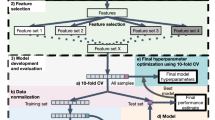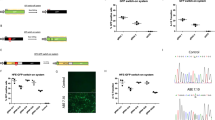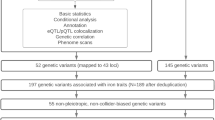Abstract
As the results of the Human Genome Project are realised, screening for genetic mutations that predispose to preventable disease is becoming increasingly possible. How and where such screening should best be offered are critical, unanswered questions. This study aimed to assess the acceptability and feasibility of genetic screening for preventable disease, using the model of hereditary haemochromatosis, in high-school students. Screening was offered for the HFE C282Y substitution to 17 638 students. Questionnaires were administered at the time of screening (Q1) and approximately 1 month after results were communicated (Q2). Outcomes assessed were uptake of screening, change in scores of validated anxiety, affect and health perception scales from Q1 to Q2, knowledge and iron indices in C282Y homozygous individuals. A total of 5757 (32.6%) students had screening and 28 C282Y-homozygous individuals (1 in 206) were identified, and none of the 27 individuals who had iron indices measures had significant iron overload. There was no significant change in measures of anxiety, affect or health perception in C282Y homozygous or non-homozygous individuals. Over 86% of students answered each of five knowledge questions correctly at Q1. Genetic population-based screening for a preventable disease can be offered in schools in a way that results in minimal morbidity for those identified at high risk of disease. The results of this study are not only relevant for haemochromatosis, but for other genetic markers of preventable disease such as those for cardiovascular disease and cancer.
Similar content being viewed by others
Log in or create a free account to read this content
Gain free access to this article, as well as selected content from this journal and more on nature.com
or
References
Calzone K, Wattendorf D, Dunn BK : The application of genetics and genomics to cancer prevention. Semin Oncol 2010; 37: 407–418.
Humphries SE, Drenos F, Ken-Dror G, Talmud PJ : Coronary heart disease risk prediction in the era of genome-wide association studies: current status and what the future holds. Circulation 2010; 121: 2235–2248.
Delatycki MB : Population screening for reproductive risk for single gene disorders in Australia: now and the future. Twin Res Hum Genet 2008; 11: 422–430.
Allen KJ, Gurrin LC, Constantine CC et al: Iron-overload-related disease in HFE hereditary hemochromatosis. N Engl J Med 2008; 358: 221–230.
Beutler E, Felitti VJ, Koziol JA, Ho NJ, Gelbart T : Penetrance of 845G--> A (C282Y) HFE hereditary haemochromatosis mutation in the USA. Lancet 2002; 359: 211–218.
Allen KJ, Warner B, Delatycki MB : Clinical haemochromatosis in HFE mutation carriers. Lancet 2002; 360: 412–413, .
Cox T, Rochette J, Camaschella C, Walker A, Robson K : Clinical haemochromatosis in HFE mutation carriers. Lancet 2002; 360: 412.
Poullis A, Moodie SJ, Maxwell JD : Clinical haemochromatosis in HFE mutation carriers. Lancet 2002; 360: 411–412.
Patch C, Roderick P, Rosenberg W : Factors affecting the uptake of screening: a randomised controlled non-inferiority trial comparing a genotypic and phenotypic strategy for screening for haemochromatosis. J Hepatol 2005; 43: 149–155.
Delatycki MB, Allen KJ, Nisselle AE et al: Use of community genetic screening to prevent HFE-associated hereditary haemochromatosis. Lancet 2005; 366: 314–316.
Cadet E, Capron D, Gallet M et al: Reverse cascade screening of newborns for hereditary haemochromatosis: a model for other late onset diseases. J Med Genet 2005; 42: 390–395.
Gason AA, Aitken MA, Metcalfe SA, Allen KJ, Delatycki MB : Genetic susceptibility screening in schools: attitudes of the school community towards hereditary haemochromatosis. Clin Genet 2005; 67: 166–174.
Gason A, Sheffield E, Bankier A et al: Evaluation of a Tay-Sachs disease screening program. Clin Genet 2003; 63: 386–392.
Mitchell JJ, Capua A, Clow C, Scriver CR : Twenty-year outcome analysis of genetic screening programs for Tay-Sachs and beta-thalassemia disease carriers in high schools. Am J Hum Genet 1996; 59: 793–798.
Metcalfe SA, Aitken M, Gaff CL : The importance of program evaluation: how can it be applied to diverse genetics education settings? J Genet Couns 2008; 17: 170–179.
Delatycki MB, Wolthuizen M, Collins V et al: Implementation of ironXS: a study of the acceptability and feasibility of genetic screening for hereditary hemochromatosis in high schools. Clin Genet 2010; 77: 241–248.
Delatycki M, Allen K, Williamson R : Insurance agreement to facilitate genetic testing. Lancet 2002; 359: 1433.
Ware Jr JE, Sherbourne CD : The MOS 36-item short-form health survey (SF-36). I. Conceptual framework and item selection. Med Care 1992; 30: 473–483.
Marteau TM, Bekker H : The development of a six-item short-form of the state scale of the Spielberger State-Trait Anxiety Inventory (STAI). Br J Clin Psychol 1992; 31: 301–306.
Spielberger C, Gorusch R, Luchene R : State-Trait Anxiety Inventory: Manual. Consulting Psychologists Press: Palo Alto, 1983.
Melvin GA, Molloy GN : Some psychometric properties of the Positive and Negative Affect Schedule among Australian youth. Psychol Rep 2000; 86: 1209–1212.
Watson D, Clark LA, Tellegen A : Development and validation of brief measures of positive and negative affect: the PANAS scales. J Pers Soc Psychol 1988; 54: 1063–1070.
Horowitz M, Wilner N, Alvarez W : Impact of Event Scale: a measure of subjective stress. Psychosom Med 1979; 41: 209–218.
Gason AA, Metcalfe SA, Delatycki MB et al: Tay Sachs disease carrier screening in schools: educational alternatives and cheekbrush sampling. Genet Med 2005; 7: 626–632.
Schmitt B, Golub RM, Green R : Screening primary care patients for hereditary hemochromatosis with transferrin saturation and serum ferritin level: systematic review for the American College of Physicians. Ann Intern Med 2005; 143: 522–536.
Power TE, Adams PC, Barton JC et al: Psychosocial impact of genetic testing for hemochromatosis in the HEIRS Study: a comparison of participants recruited in Canada and in the United States. Genet Test 2007; 11: 55–64.
Wenzel LB, Anderson R, Tucker DC et al: Health-related quality of life in a racially diverse population screened for hemochromatosis: results from the Hemochromatosis and Iron Overload Screening (HEIRS) study. Genet Med 2007; 9: 705–712.
Patch C, Roderick P, Rosenberg W : Comparison of genotypic and phenotypic strategies for population screening in hemochromatosis: assessment of anxiety, depression, and perception of health. Genet Med 2005; 7: 550–556.
Power TE, Adams PC : Psychosocial impact of C282Y mutation testing for hemochromatosis. Genet Test 2001; 5: 107–110.
Nisselle AE, Collins VR, Gason AA et al: Educational outcomes of a workplace screening program for genetic susceptibility to hemochromatosis. Clin Genet 2006; 69: 163–170.
Frumkin A, Zlotogora J : Genetic screening for reproductive purposes at school: is it a good strategy? Am J Med Genet A 2008; 146A: 264–269.
Allen K, Williamson R : Screening for hereditary haemochromatosis should be implemented now. BMJ 2000; 320: 183–184.
Haddow JE, Bradley LA : Hereditary haemochromatosis: to screen or not. Conditions for screening are not yet fulfilled. BMJ 1999; 319: 531–532.
Hall MA, Barton JC, Adams PC et al: Genetic screening for iron overload: No evidence of discrimination at 1 year. J Fam Pract 2007; 56: 829–834.
Smith CO, Lipe HP, Bird TD : Impact of presymptomatic genetic testing for hereditary ataxia and neuromuscular disorders. Arch Neurol 2004; 61: 875–880.
Acknowledgements
This study was funded by the National Health and Medical Research Council (491224) and the Jack Brockhoff Foundation. MBD is a National Health and Medical Research Council (Australia) Practitioner Fellow. KJA is Viertel Senior Medical Research Fellow.
Author information
Authors and Affiliations
Corresponding author
Ethics declarations
Competing interests
The authors declare no conflict of interest.
Additional information
Supplementary Information accompanies the paper on European Journal of Human Genetics website
Supplementary information
Rights and permissions
About this article
Cite this article
Delatycki, M., Wolthuizen, M., Collins, V. et al. ironXS: high-school screening for hereditary haemochromatosis is acceptable and feasible. Eur J Hum Genet 20, 505–509 (2012). https://doi.org/10.1038/ejhg.2011.247
Received:
Revised:
Accepted:
Published:
Issue date:
DOI: https://doi.org/10.1038/ejhg.2011.247
Keywords
This article is cited by
-
Clinical practice guidelines on hemochromatosis: Asian Pacific Association for the Study of the Liver
Hepatology International (2023)
-
Responsible implementation of expanded carrier screening
European Journal of Human Genetics (2016)
-
A Systematic Review and Narrative Synthesis of Health Economic Studies Conducted for Hereditary Haemochromatosis
Applied Health Economics and Health Policy (2015)



